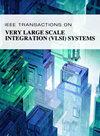A 28 nm 16-kb Sign-Extension-Less Digital-Compute-in-Memory Macro With Extension-Friendly Compute Units and Accuracy-Adjustable Adder-Tree
IF 2.8
2区 工程技术
Q2 COMPUTER SCIENCE, HARDWARE & ARCHITECTURE
IEEE Transactions on Very Large Scale Integration (VLSI) Systems
Pub Date : 2024-07-03
DOI:10.1109/TVLSI.2024.3418888
引用次数: 0
Abstract
Conventional digital-domain SRAM compute-in-memory (CIM) faces challenges in handling multiply-and-accumulate (MAC) operations with signed values, either in serial data feeding mode or extra sign-bit processing. The proposed CIM macro has the following features: 1) a sign-extension-less array multiplication circuit structure that eliminates the need for converting partial sums into 2’s complement, which removes the constraints related to handling specific symbol bits; 2) developing a circuit that avoids signed bit extension shift and accumulate, resulting in reduced area cost; and 3) integrating an adder structure that provides adjustable accuracy, thereby enhancing network adaptability as compared to traditional approximation techniques. A fabricated 28 nm 16-kb sign-extension-less DCIM was tested with the highest MAC speed with 5.6 ns (Signed 8 b IN&W 23 b Out) and achieved the best energy efficiency with 40.15 TOPS/W over a wide range of network adaptability.具有便于扩展的计算单元和精度可调加法器树的 28 纳米 16-kb 无符号扩展数字内存计算宏程序
传统的数字域 SRAM 内存计算 (CIM) 在处理带符号值的乘法累加 (MAC) 运算时面临挑战,无论是串行数据输入模式还是额外的符号位处理。拟议的 CIM 宏具有以下特点:1) 无符号扩展的阵列乘法电路结构,无需将部分和转换为 2 的补码,从而消除了与处理特定符号位相关的限制;2) 开发了一种避免符号位扩展移位和累加的电路,从而降低了面积成本;3) 集成了一种加法器结构,可提供可调精度,从而与传统近似技术相比增强了网络适应性。经测试,28 纳米制造的 16-kb 无符号扩展 DCIM 的 MAC 速度最高,为 5.6 ns(符号 8 b IN&W 23 b Out),并在广泛的网络适应性范围内实现了 40.15 TOPS/W 的最佳能效。
本文章由计算机程序翻译,如有差异,请以英文原文为准。
求助全文
约1分钟内获得全文
求助全文
来源期刊
CiteScore
6.40
自引率
7.10%
发文量
187
审稿时长
3.6 months
期刊介绍:
The IEEE Transactions on VLSI Systems is published as a monthly journal under the co-sponsorship of the IEEE Circuits and Systems Society, the IEEE Computer Society, and the IEEE Solid-State Circuits Society.
Design and realization of microelectronic systems using VLSI/ULSI technologies require close collaboration among scientists and engineers in the fields of systems architecture, logic and circuit design, chips and wafer fabrication, packaging, testing and systems applications. Generation of specifications, design and verification must be performed at all abstraction levels, including the system, register-transfer, logic, circuit, transistor and process levels.
To address this critical area through a common forum, the IEEE Transactions on VLSI Systems have been founded. The editorial board, consisting of international experts, invites original papers which emphasize and merit the novel systems integration aspects of microelectronic systems including interactions among systems design and partitioning, logic and memory design, digital and analog circuit design, layout synthesis, CAD tools, chips and wafer fabrication, testing and packaging, and systems level qualification. Thus, the coverage of these Transactions will focus on VLSI/ULSI microelectronic systems integration.

 求助内容:
求助内容: 应助结果提醒方式:
应助结果提醒方式:


